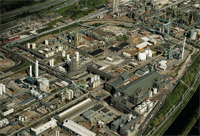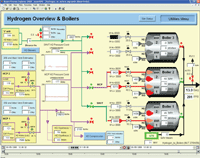INEOS project reduces energy bill by £3m
18 Mar 2010
Philip Masding, process control manager at INEOS Chlor, on how a project to channel hydrogen gas by-product to its boilers has led to huge energy savings at Runcorn site

INEOS Chlor’s Runcorn facility is one of Europe’s largest chlorine production sites
INEOS Chlor is one of the major chlor-alkali and chlorine derivative producers in Europe. Its Runcorn site in north west England has two large chlorine plants: the original J Unit that uses a mercury cell electrolysis process route, and the more recently opened Genesis Membrane Chlorine Plant (MCP).
Continuous improvement of the manufacturing processes has taken the Runcorn site to a ’best in class’ cost base and environmental performance, and as part of this improvement programme the company wanted to minimise vented hydrogen and maximise the value of this resource at both plants.
Without a significant change in market demand for hydrogen, it was not possible to increase sales to existing customers. The only alternative was to increase the amount used as fuel to power on-site boilers, thereby reducing costs for purchased natural gas.
This wasn’t as simple as just redirecting all the available hydrogen to the boilers. The burners on the boilers are very sensitive to wide variations in hydrogen pressure, which can lead to boiler trips.
Such variations can be caused by start-up or shutdown of a hydrogen compressor supplying external customers, by shutdown of a chlorine production stream, or by a sudden change in output from a chlorine production stream as can occur when an individual electrolyser is switched off. The MCP process itself is also sensitive to boiler start-ups and trips, which can cause back pressures that might damage the membrane.
The challenge, therefore, was to increase the hydrogen to the boiler, while at the same time protecting both the boiler and the plant from pressure disturbances.
Controlling pressure variations
The events that create disturbances in the system are inevitable. Engineers, therefore, needed to develop an advanced control scheme that could minimise resulting pressure variations. Their approach was a mixture of feedback, or PID control, and predetermined valve movements to keep the differential pressure within defined bounds.
To implement this control scheme, the team took advantage of the automation system that already controlled the boiler plant and both chlorine plants at the Runcorn site. A component of Emerson’s PlantWeb digital plant architecture, the DeltaV automation system offered advanced control capabilities ideal for this approach.
The team first built a mathematical model of the process and implemented a dynamic model of the entire system for simulation purposes. Several control scheme designs were tested within the dynamic simulator. This enabled them to understand fully if each design was accurate and whether it would work.

Phil Masding
The testing process revealed a need to completely isolate a hydrogen stream if a boiler tripped at a significant load. The export valve is then closed rapidly and the vent valve opened to a load-dependent position that allows it to vent all the current hydrogen production.
A control scheme was selected that promised the best results, and a process engineer verified that it would meet both production and safety requirements. This solution was configured in the control system - a task made easier by the DeltaV system’s range of available function blocks and the flexibility to write custom code as needed.
Providing flexibility
Previously, hydrogen supplied to external customers was produced only at the older J Unit. Switching to cleaner, mercury-free hydrogen produced by the MCP facility’s advanced membrane-cell electrolysis method meant a higher-quality product for customers, while hydrogen from the J Unit was used to power the on-site boiler.
The MCP had not previously supplied hydrogen externally, so INEOS had to design and implement a control strategy for the flexible use of compressors to service a variable demand. The strategy had to prevent extreme differential pressures - from a compressor start-up, for example - that could cause the MCP to trip or damage its membranes.
Once again, the engineers set about designing, modelling and testing various control strategies until they found one that allowed the compression plant to be linked to the MCP without unacceptable disturbances. The dynamic modelling function enabled an accurate prediction of system performance before commissioning took place. This gave everyone confidence that investing in the compression project would pay off.
Disturbances in the system are inevitable. Engineers, therefore, needed to develop an advanced control scheme that could minimise resulting pressure variations
Differential pressure variations potentially affecting the compressor, burners and MCP membrane are now monitored and controlled by the control system. An auto-isolation limit was implemented to vent off hydrogen temporarily to prevent any damage to the membrane.
Previously, hydrogen from only a single production stream (either MCP1 or MCP2) was sent to the boilers at any one time because pressure variations between the two streams increased risk of a boiler trip. As the new control strategy minimised these variations, INEOS was immediately able to use a dual stream, so increasing the amount of hydrogen that could be sent to the boilers.
When a production electrolyser in the MCP is offline, it is purged with nitrogen gas. The new system enables this nitrogen to be removed without disturbing the hydrogen pressure; ensuring that customers receive pure hydrogen - and avoiding MCP trips.

Hydrogen from the older J Unit is now typically routed to the on-site boilers. A portion of the hydrogen from the newer MCP Unit also goes to the boilers, while another portion is routed to the new compressor station and then to outside customers
Critical instrumentation
Critical to the new control strategies is the performance of the instrumentation and specifically the control valves. Runcorn depends on these to work precisely, otherwise the entire system is affected and the site would not be able to reach optimum plant performance levels.
Maintaining instrument and valve performance is supported by Rosemount pressure and flow devices and Fisher intelligent valves, used throughout the compressor, boiler and chlorine processing plants. Like the control system, they are part of Emerson’s PlantWeb digital plant architecture and communicate instrument health as well as process information via Foundation fieldbus.
INEOS Chlor uses Emerson’s AMS Suite predictive maintenance software and AMS ValveLink software to check that valves are working at optimum levels.
Once again, we set about designing, modelling and testing various control strategies until we found one that allowed the compression plant to be linked to the MCP without unacceptable disturbances
All design and installation was undertaken by INEOS Chlor over an 18-month period - reflecting the engineers’ cautious approach to introducing the new systems.
The control strategy was introduced gradually to smooth its acceptance by the production team, and allow engineers to verify that performance fully met the modelled predictions. This was done in two major phases, each time increasing the amount of hydrogen that could be burned in the boilers.
A new monitoring system was also implemented to calculate venting totals and costs based on actual gas prices. Since starting the project, hydrogen venting has been reduced by 90%; the resulting increase in hydrogen available to fuel the boilers saving around £3 million a year in natural gas, depending on gas prices. The improved control has also prevented 10 or more boiler trips and dozens of events that would have exposed MCP membranes to high (>70mbar) differential pressure.
The Runcorn team has recently designed further improvements to the MCP differential control system that provide an instant response to load changes, and also an improved response to boiler starts and trips below the auto-isolation limit.







